#Rossie (1807)
Text

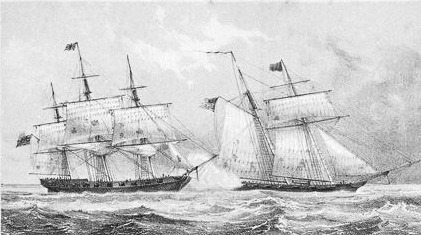
The American Clipper USS Rossie and British ship, Princess Amelia engaging, on September 16, 1812.
"Commodore Joshua Barney in the Baltimore-built Clipper Schooner USS Rossie of 14 guns and 120 men sailed on September 7. On the 9th, a British squadron of 3 ships vainly tried to overhaul him and, on the 12th, a British frigate chased him for 6 hours and then gave up. On the 16th, ROSSIE fell in with the British ship, PRINCESS AMELIA, an armed trader, and for one hour there was a steady combat. The Rossie was badly cut up in sails and rigging but her hull and spars escaped. She had 7 men hurt, one severely. The PRINCESS AMELIA was badly cut up alow and aloft and had her captain, sailing master, and a seaman killed and 7 wounded before she surrendered."
NHHC: USN 903308
#USS Rossie#USS Rossie (1807)#schooner#Clipper#Rossie (1807)#Rossie#Princess Amelia (1799)#SS Princess Amelia#Princess Amelia#SS Rossie#Sailing Ship#War of 1812#Privateer#United States Navy#U.S. Navy#US Navy#USN#Navy#September#1812#my post
51 notes
·
View notes
Text
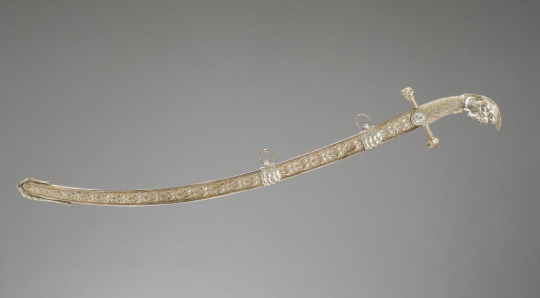
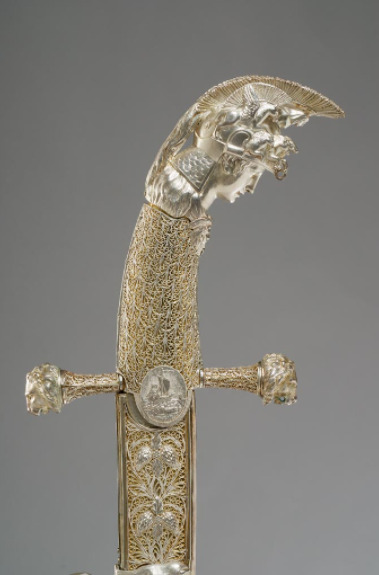
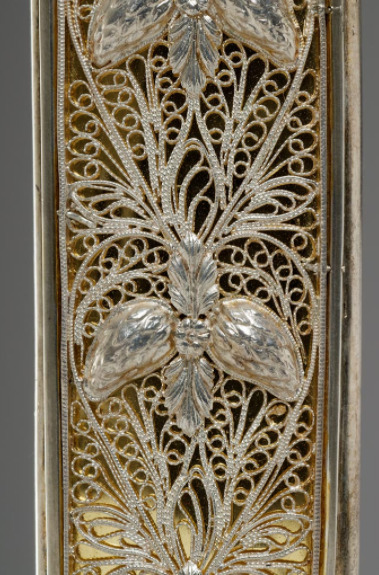
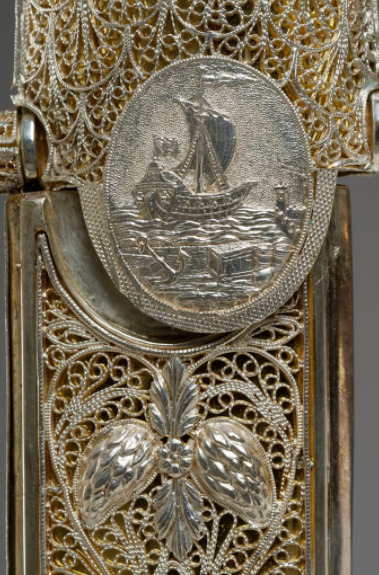
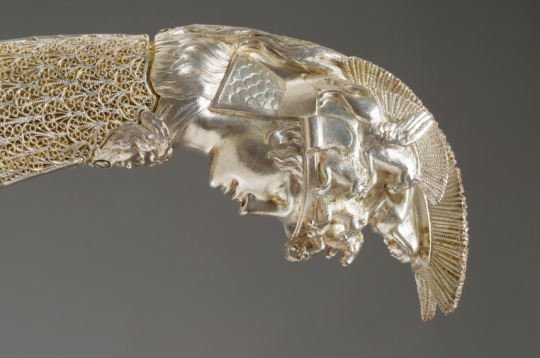
Silver decorated saber crafted by Anton Rossi of Vienna, dated 1807
from The Museum of Applied Arts, Budapest
600 notes
·
View notes
Text
“Of Glory” by Giulio Bussi (1),Translated by Sir Aubrey de Vere (2), Samuel Waddington, comp. “The Sonnets of Europe”. 1888.
Glory, what art thou? Thee, despite of pain,
And want, and toil, the brave heart cherisheth:
Thee the pale student courts, wasting, in vain,
His primal youth, thy worshipper in death.
Glory, what art thou? Thine imperial breath
Speaks woe to all: with pangs do men obtain
An empty boon that duly perisheth,
Whose very fear of loss outweighs the gain.
Glory, what art thou then? A fond deceit,
Child of long suffering, empty air, a sweet
Prize that is sought with toil, but never found:
In life, by every envious lip denied;
In death, to ears that hear not a sweet sound:
Glory—thou fatal scourge of human pride!
I care not whose it was, mine it is now.
Illustration: “Camillus, Allegory of Glory” (3), ceiling fresco by Mariano Rossi (4)- Galleria Borghese - Rome, Italy.(5)
Notes: Count Giulio Bussi (born March 12, 1646 in Viterbo - died April 14, 1714 in the same city) was an Italian poet. Giulio Bussi was chamberlain to Pope Clement XI, and died in Viterbo on April 14, 1714. He was a member of the Academy of Arcadia in Rome. In addition to several musical dramas, comedies, and various poems, he published a verse translation of Ovid's “Heroides: Epistole eroiche d'Ovidio” translated in terza rima, Viterbe, 1703-1711, 2 parts in-12. It has been inserted, in part, into t. 24 of the large collection of translations of classical poets, printed in Milan, 1745, in-4°
(2) Sir Aubrey (Hunt) de Vere, 2nd Baronet (28 August 1788 – 5 July 1846)[3][2] was an Anglo-Irish poet and landowner. De Vere was the son of Sir Vere Hunt, 1st Baronet and Eleanor Pery, daughter of William Pery, 1st Baron Glentworth and his first wife Jane Walcott. He was educated at Harrow School, where he was a childhood friend of Lord Byron, and Trinity College, Dublin. He married Mary Spring Rice, the daughter of Stephen Edward Rice and Catherine Spring, and sister of Thomas Spring Rice, 1st Baron Monteagle of Brandon, in 1807. He succeeded to his father's title in 1818. He and Mary had five sons, including the third and fourth baronets, Aubrey and Stephen de Vere, and the poet Aubrey Thomas de Vere, and three daughters, two of whom died in infancy.
The Hunt/de Vere family estate for 300 years (1657–1957), including the period of the de Vere Baronetcy of Curragh, is the present-day Curraghchase Forest Park, in County Limerick. De Vere spent most of his life on the estate and was closely involved in its management. He suffered much trouble from his ownership of the island of Lundy, which his father, who was a notoriously poor businessman, had unwisely purchased in 1802, and which became a heavy drain on the family's finances. Sir Vere was never able to find a purchaser for Lundy, and it took his son until 1834 (or 1830) to dispose of it.
Sir Aubrey stood for election in the 1820 General Election and came in third with 2921 votes. He changed his surname from Hunt to de Vere on 15 March 1832, in reference to his Earl of Oxford ancestors, dating back to Aubrey de Vere I, a tenant-in-chief in England of William the Conqueror in 1086. He served as High Sheriff of County Limerick in 1811.
Wordsworth called his sonnets the most perfect of the age. These and his drama, “Mary Tudor: An Historical Drama”, were published by his son the poet Mr. Aubrey Thomas de Vere in 1875 and 1884.
De Vere produced numerous works over his lifetime. The most notable are: “Ode to the Duchess of Angouleme” (1815), “Julian the Apostate: A Dramatic Poem” (1822), “The Duke of Mercia: An Historical Drama” [with] “The Lamentation of Ireland, and Other Poems” (1823), “A Song of Faith: Devout Exercises and Sonnets” and his most famous work, “Mary Tudor: An Historical Drama.”
(3) Marcus Furius Camillus (possibly c. 448 – c. 365 BC[1]) is a semi-legendary Roman statesman and politician during the early Roman republic who is most famous for his capture of Veii and defence of Rome from Gallic sack after the Battle of the Allia. Modern scholars are dubious of Camillus' supposed exploits and believe many of them are wrongly attributed or otherwise wholly fictitious.The cognomen Camillus derives from the title of an aristocratic youth who helped in religious duties; it is possible that a young Camillus served in such a position. His filiation is identical with that of the consul of 413 BC, Lucius Furius Medullinus, which may indicate that Medullinus and Camillus were brothers.
Camillus is first firmly recorded as entering public office in 401 BC. He served in that year and again in 398 BC as consular tribune against the Falisci and the Capenates. Both were tribes near Rome and Veii. His first supposed office was that of censor (before having held any other public office) in the year 403 BC. He was then supposed to have, as dictator completed a campaign against Veii which saw the city captured in 396 BC. The specific story of Veii's capture in Livy is mostly legendary. After a ten-year siege (the third Veientine war) – "obviously modelled on the Greek legend of the Trojan war" – the Alban Lake rises supernaturally after a supposed prophecy of Veii's destruction in its "Books of Fate". The Romans then extirpate the prodigy by building a tunnel to drain the lake after being so instructed by the oracle at Delphi. Camillus, as commander, then persuades Veii's goddess, Juno Regina, to leave the city and move to Rome. Archaeological remains near Veii include blocked drainage tunnels from the fifth-century, which may indicate the possibility that this story in Livy arises a Romans breakthrough into the city through them.
Following the capture of the city, Livy reports that Camillus had its free population sold into slavery before the land was resettled with Roman citizens with land allotments of seven jugera. Archaeological evidence points to Romans switching quarries: after the capture of Veii's better-quality quarries, Roman structures switch largely to using stone sourced therefrom, which may suggest enslaved Veientine quarry workers. Camillus then celebrates a triumph and dedicates a temple of Juno on the Aventine. It is likely that many of the details of his return in Livy were copied from the less historically distant triumphal entrances of Scipio Africanus or Sulla.
In 394 BC, he supposedly secured the surrender of the Falisci in their main town of Falerii Veteres (modern Civita Castellana) after refusing to accept pupils from a schoolmaster as hostages. Much of the Livian narrative about the exchange with the schoolmaster is meant to recount an exemplum which stresses the importance of Roman good will (Latin: fides) and the importance of gentlemanly aristocratic behaviour. After taking Veii and Falisci, Camillus is supposed to have been prosecuted. Accounts differ: he may have been accused by the quaestors of misappropriating spoils of war or of his extravagance in purchasing four white horses for his triumph. Whatever the charge, though a quaestorian trial for misappropriation is more likely, Camillus was reportedly convicted and sent into exile. Historians believe this story of disgrace before the courts is modelled on fates of Achilles and Scipio Africanus and is meant to draw comparison with Themistocles and Gnaeus Marcius Coriolanus. The underlying source for the story likely postdates the Sullan period and is an "evident anachronism".The story of conviction, however, likely did not happen and was instead adduced to place Camillus away from Rome when the Gallic sack occurs, excusing him of any blame for Rome's defeat.
In 390 BC (Varronian), more likely in actuality 387 BC, a large group of Gauls crossed the Apennines into northern Etruria.They advanced until they reached Roman territory and there defeated Rome's army at the Battle of the Allia. In the following days, they entered Rome and sacked it. They then induced the surrender of Roman holdouts on the Capitoline hill before receiving a large ransom of gold and withdrawing north. This account is corroborated by Greek sources as early as the 4th century BC; Polybius places the sack in the same year as the Peace of Antalcidas and the siege of Rhegium.
According to Livy, after the fall of the city, Camillus is recalled from exile at Ardea by the people and appointed again as dictator – even though a consular tribune was available to nominate a dictator in the normal fashion – in the city's hour of need. Then, at the climax of the Gallic sack, when a thousand pounds of gold is being weighed out, Camillus and a hastily organised army returns and defeats the Gauls, saving the city and recovering the ransom. This story was probably a creation of Roman annalists during the first century BC; Ogilvie in his Commentary on Livy, calls it "one of the most daring fabrications in Roman history.”
Other traditions have different narratives: for example, the Livii Drusi are supposed to have by single combat with a Gaul named Drausus recovered the same ransom; Plutarch records a fragment of Aristotle asserting that "a certain Lucius" (probably a Lucius Albinius who is recorded to have secreted away the Vestal Virgins and sacred objects to Caere) having saved the city. Polybius reports that rather than being defeated by Camillus, the Gauls occupied the city for some seven months before the Romans bought them off and they departed of their own accord to deal with an invasion of their territory by the Veneti. While the literary sources assert Rome was sacked and had to be rebuilt, there is no archaeological evidence of major damage to pre-fourth century BC buildings in the forum, which indicates that the sack – if it occurred – consisted largely of stealing portable property.
After the sack, Camillus is supposed to have led the opposition to a proposal circulating among the plebs to relocate the city to Veii. This story also cannot be accepted and is more likely "a reflection of the tensions that arose concerning the distribution of the conquered territory of Veii" and to introduce "anti-plebeian elements" into the Camillan narrative. The speech does not appear in Polybius and may have been invented c. 122 BC in order to oppose by historical precedent Gaius Gracchus' proposal to establish a colony at Carthage with further embellishment of its anti-Italian themes during the time of the Social War.
Regardless, the ancient tradition records that within a year after Rome was reduced to ruins, the city had been completely rebuilt and all rebellions by Roman allies suppressed due to the extraordinary leadership of Camillus, who is therefore regarded as the city's "second founder.” In these victories, he is supposed to have dedicated three gold saucers to Juno for victory against the Volscians, Aequians, and Etruscans all the next year in 389 BC. None of these achievements are mentioned in Polybius or Diodorus.
After his probably fictitious victories, Livy next reports Rome sending Camillus to take the city of Tusculum in 381 BC. The city, already surrounded by Roman territory, immediately surrenders and the inhabitants thereof are given Roman citizenship with some level of self-rule, becoming the first Roman municipium. Later sources view this as an act of magnanimity due to the later elevated status of municipia but at the time it was likely little more than annexation; Tusculum would be one of the first to revolt in the Second Latin War. Both Camillus' role in Manlius' sedition and his later dictatorship (engaging the Gauls and plebeian reforms) may be anachronistic and fictitious insertions.
The account of Dio, coming from a Byzantine summary by Zonaras, asserts Camillus was elected dictator in 384 BC to put down the sedition of Marcus Manlius Capitolinus, who is believed to be trying to make himself king. Camillus reportedly has Manlius arrested by a slave before a trial; Manlius is convicted and then thrown from the Tarpeian Rock. No such attribution is given in the accounts of Livy and Plutarch, who note Camillus merely as one of the six consular tribunes in that year.[
According to Livy, there are ten years in which Gaius Licinius Stolo and Lucius Sextius Lateranus were elected plebeian tribunes continuously. During the last five or six years, they blocked the election of all magistrates in an attempt to pass what would become the Licinio-Sextian rogations. Camillus is alleged to have been elected dictator in 368 BC and attempted to obstruct their attempts, without success. But the next year, he is appointed dictator again. He then reconciles the plebeians and the patricians with a proposal to appoint a patrician-only praetor and curule aediles (in exchange for plebeian eligibility to the consulship); all accept the passage of the rogations and domestic harmony is restored; Camillus then constructs a temple to Concordia. "Very little of this narrative can be accepted as it stands". While Diodorus Siculus reports the length of the anarchy to have been merely one year, it is implausible that Rome could have been without magistrates for more than a few months. More damningly, a passage of Aulus Gellius' “Attic Nights” (5.4) preserves a fragment of Numerius Fabius Pictor that shows that alleged years where tribunes blocked all elections were a late annalistic invention, likely to line up Greek and Roman chronologies.
The three alleged rogations touched on a number of topics. The first rogation was a mechanism for debt relief. The second imposed a possession limit of 500 jugera of public land. The third was the reform that abolished the consular tribunate and required the election of consuls, one of which had to be a plebeian. Gary Forsythe, in “Critical history of early Rome”, accepts that the first law is consistent with voiced concerns over indebtedness from this period, that the second (limits on public land possession) is attested to in later speeches, and that the third is reflected in the consular fasti. Livy includes in the same year of this compromise, 367 BC, another alleged victory by Camillus over the Gauls. Modern scholars are especially suspicious of this report, especially because Livy notes confusion in his own sources over this victory, which is alternatively attributed to Titus Manlius Torquatus.
According the ancient Roman tradition, Camillus died during an epidemic that hit Rome in 365 BC. However, it is unlikely that any evidence of Camillus' death was known in later times: Münzer, writing in the “Realencyclopädie,” believes later annalists simply assumed Camillus died in the epidemic.
The traditional account of Camillus' life comes from Livy and Plutarch's eponymous “Life.” But these were based on a larger annalistic tradition which painted Camillus as the dominant figure in this period of history; Livy, for his part, organised his fifth and sixth books around Camillus' career (Camillus enters public office at the start of the fifth book and leaves it at the end of the sixth). Little evidence of this tradition survives, though fragments of Quintus Claudius Quadrigarius' work indicate that the myth of Camillus was well-established by the 80s and 70s BC.
The name Camillus is attested in the Etruscan François Tomb, built c. 300 BC near Vulci. One of the paintings therein describes a "Gneve Tarchunies Rumach" (probably Gnaeus Tarquinius the Roman) being killed by a "Marce Camitlnas" (possibly Marcus Camitilius or Marcus Camillus). It is not known, however, what specific legend the tomb depicts. Some scholars have suggested that Camitlnas refers to the Camillus of this article, but such attribution is problematic. Scholars believe Camillus qua person probably existed: the fasti, if believed, record his importance and influence in Roman public life at this time. But, in general, the quality of the sources – which interject "plenty of myth, embellishment, and fantasy" – led Mary Beard, in the book “SQPR,” to write "Camillus is probably not much less fictional than the first Romulus". Mommsen, writing in “Römisches Strafrecht,” called Camillus' legend "the most dishonest of all Roman legends". Tim Cornell, writing of Camillus, calls him "the most artificially contrived of all Rome's heroes". The source of scholars have suggested that Camillus emerged from a popular oral tradition which linked the names Camillus, Manlius Capitolinus, and Sulpicius to inscriptions placed on the temple of Juno Moneta (erected in 345 BC by Lucius Furius Camillus).
By the late republic, after centuries of embellishment from the fourth to the first century BC, the Romans believed that Camillus had captured Veii, saved the city from the Gallic sack, saved the city from foreign threats on all sides, opened the highest magistracies to the plebeians, ensured domestic harmony, and largely settled the struggle of the orders. Through it all, they believed he had held six consular tribunates and been dictator five times. For these reasons, he was hailed as the second founder of the city. A bronze statue of Camillus also bedecked itself on the rostra in the Forum.
His reputation by the Late Republic and Early Empire was such that Camillus was a source of exempla: fables giving lessons for Romans on how to act in line both with morals and with Roman tradition and procedures. One of the most famous ones is during Camillus' capture of Faliscii: one of their schoolmasters defects, bringing with him to the camp his pupils who are Faliscan nobles' children. Camillus, displaying his exemplary fides, has the schoolmaster reprimanded and punished by the pupils; the Faliscans then surrender the city before Camillus' good faith. Camillus is similarly alleged to have resigned a dictatorship to which he was appointed merely because of faulty procedure; Livy mentions it – an event that "almost certainly never took place" – as an example of Roman legal scruples. In all, Camillus is mentioned in Livy's “Ab urbe condita” as an example to be followed eight times, an "unusually high frequency", usually in relation to his alleged successes as a general, moderation in the face of hot-headed colleagues, and triumphant recall from exile.
The memory of Camillus became part of the public image of the first Roman emperor Augustus. The history of Livy, for example, may have been written to coincide at the beginning of a great year consisting of 360–365 years. Starting with Romulus, the cycle reaches a peak under King Servius Tullius before a second founding under Camillus, completing the cycle. The next cycle has a second peak in the time of Scipio Africanus before Augustus enters as the figure to re-found Rome again and restart the great year, with Livy suggesting that Romulus, Camillus, and Augustus are coequal heroic figures.
(4) Mariano Rossi (7 December 1731 - 24 October 1807) was an Italian painter, persisting in what had become an anachronistic Rococo style amid an ascendant neoclassical environment. His placement legions of figures in a complex scenography and quadrature recalls the work of Pietro da Cortona.
Mariano was born to poor parents in Sciacca, Sicily. He trained first in Palermo, then in Naples, and finally in Rome, where he studied under Marco Benefial. He was patronized by the illuminated charity of men of fashion (that is, wealthy individuals) He was paid 400 zecchini by the Cardinal Cardinal Bernis for a canvas depicting Joshua commanding Sun to stand still. He painted for the churches of Purgatorio and Santa Lucia in Sciacca, Sicily. In 1766, he was called to paint frescoes for the royal court in Turin. He then returned to Rome, where he painted a fresco in the grand salon of the Villa Borghese. During 1775-1779, he painted a large ceiling fresco depicting Marcus Furius Camillus Fighting Brennus and his Gauls, while Romulus Entreats Jupiter to Help Rome. The room displays some of the ancient Roman statuary, previously collected by Camillo Borghese. Other contemporary painters active in the Villa were Laurent Pecheux and Domenico de Angelis. Mariano joined the Academy of St Luke in 1776.
The Napoleonic invasion of Rome caused him to leave for Sicily. There he painted a Roger I Liberating of Sicily from the Saracens for the Palermo Cathedral. With the Bourbon restoration in Naples, he briefly painted again at the Palace of Caserta. But on moving back to Rome in 1804, he died and was buried in the church of Santa Susanna, Rome.
(5) The great hall of the Casino in the Villa Borghese, whose interiors were remodeled in a Neoclassical style by Antonio Asprucci, was adorned with a ceiling fresco that constitute a finale to the Baroque idiom, by that time altogether passé in Rome. The pictorial program takes up the theme of the classical forebears that great Roman families had so successfully invoked to create historical legitimacy for themselves. The Sicilian painter Mariano Rossi blended the legend of the victorious hero Furius Camillus with an allegory on Rome, its founders, its virtues, and its glory.
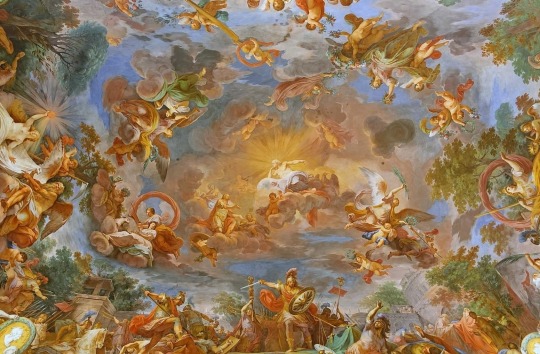
0 notes
Photo
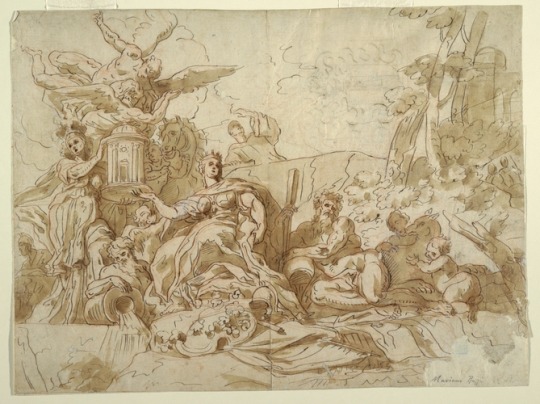
Juno, Mariano Rossi, 1731–1807, Smithsonian: Cooper Hewitt, Smithsonian Design Museum
Medium: Brush and brown wash, pen and ink, graphite on paper.
http://collection.cooperhewitt.org/view/objects/asitem/id/68302
2 notes
·
View notes
Photo

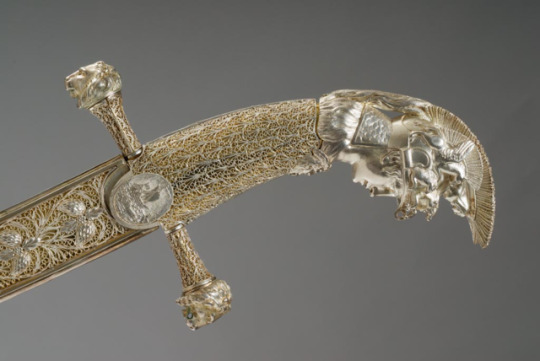
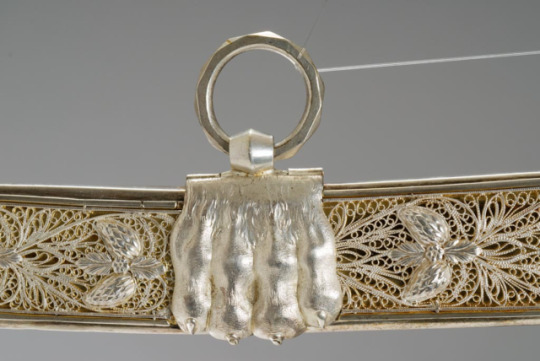
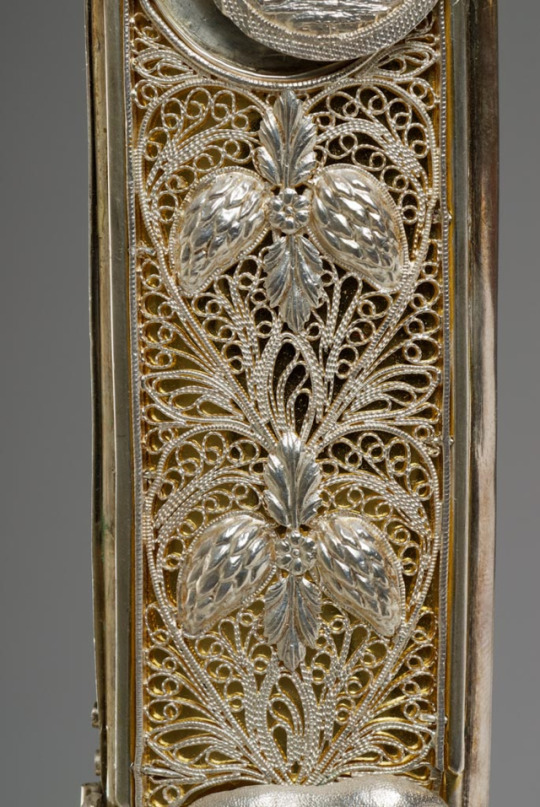
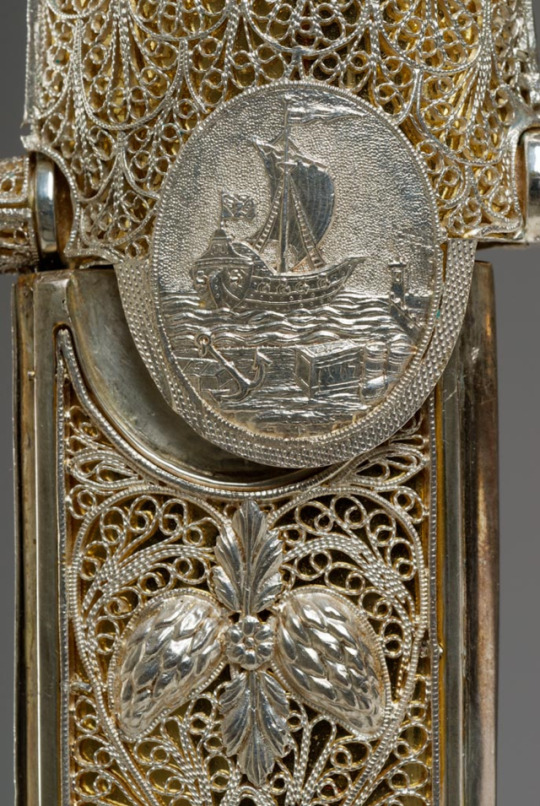
Silver mounted sabre crafted by Anton Rossi, Vienna, 1807.
from The Museum of Applied Arts, Budapest
3K notes
·
View notes
Photo
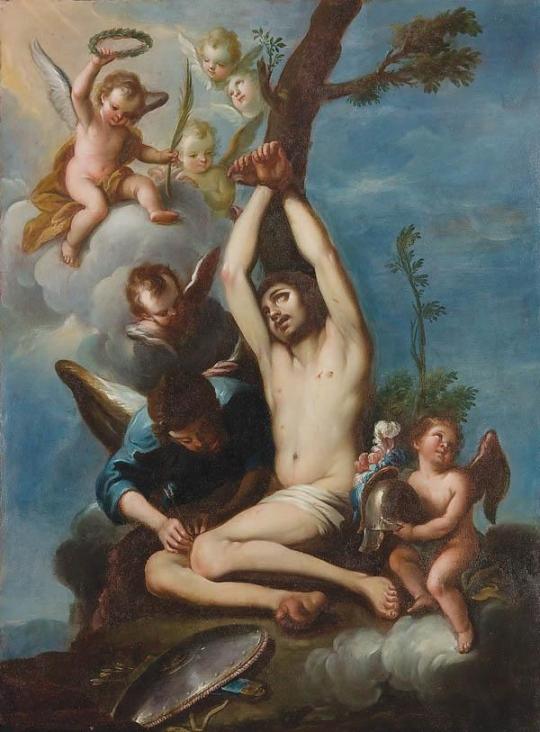
Attributed to Mariano Rossi (1731–1807)
The Martyrdom of Saint Sebastian
#Mariano Rossi#italian#baroque#art#martyrdom#Saint sebastian#putti#angels#flowers#mine#christian#religious#painting
23 notes
·
View notes
Photo
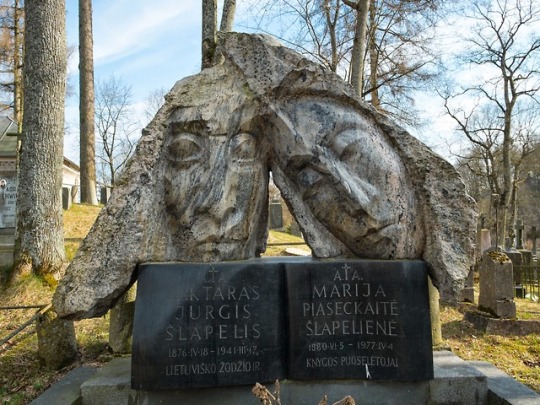
Rasos Cemetery, Vilnius - Lithuania
Rasos Cemetery (Lithuanian: Rasų kapinės, Polish: cmentarz Na Rossie w Wilnie, Belarusian: Могілкі Росы) is the oldest and most famous cemetery in the city of Vilnius, Lithuania. It is named after the Rasos district where it is located. It is separated into two parts, the old and the new cemeteries, by a narrow Sukilėliai Street. The total area is 10.8 ha. Since 1990 new burials are allowed only to family graves.
The year 1769 is cited in many sources as the date when the cemetery was founded. However, some historians believe it is a typo and the real date should be 1796.[2] On April 24, 1801 the new cemetery was consecrated. Two days later Jan Müller, the mayor of Vilnius, became the first person to be buried there. A formal document was signed in July 1801. It specified that the cemetery received 3.51 ha of land and that the cemetery will be free of charge to all city residents. It was the first cemetery in Vilnius not located next to a church.
In 1802-1807 two columbariums were built. They reached up to five stories in height and were joined at a right angle. At the end of the 19th century the columbariums began deteriorating. In between the columbariums, a neo-gothic red brick chapel was built in 1844–50. In 1888 a matching belltower was added to the chapel. At first the cemetery was surrounded by a wooden fence, but it burned down in 1812. A brick fence was rebuilt in 1820 and portions of it survive to this day.
In 1814 the cemetery was expanded as authorities bought additional land from a city resident. The addition is now known as the Hill of the Literaries (Lithuanian: Literatų kalnelis). In 1847, members of the Eastern Orthodox church opened their own cemetery next to Rasos. It was used to bury soldiers from a nearby monastery hospital and poor city residents. Therefore, it became known as the Cemetery of Orphans (Lithuanian: Našlaičių kapinės).
After World War II, the Soviet authorities demolished the right columbarium and in the 1970s razed the left columbarium. The whole necropolis was to be destroyed in the 1980s as the Soviet authorities planned a major motorway to be built directly through the cemetery. Due to a press campaign led by the Polish-language Czerwony Sztandar (Red Banner) newspaper and economic difficulties, the destruction was halted. After Lithuanian independence (1990) and the collapse of the Soviet Union(1991), Lithuanian and Polish authorities collaborated in a restoration of the cemetery.
In 1920 a war cemetery was built near the entrance for 164 Polish soldiers who fell in the city during the Polish–Soviet War and Polish–Lithuanian War.[3] It was rebuilt in 1935–1936 by Wojciech Jastrzębowski, who also designed the tombstone where the heart of Józef Piłsudski is enshrined.
Until September 18, 1939, when the Red Army entered the city, an honorary guard of three soldiers stood there at all times. Three unknown soldiers who refused to give up their arms to the Soviets in 1939 were shot on the spot and are now buried next to Marshal Piłsudski's heart. Part of the cemetery contains graves of Polish Home Armysoldiers, who fell during the Wilno Uprising. Their graves, demolished after World War II, were rebuilt by the funds of the Republic of Poland in 1993.
There is also a mass grave of Poles kidnapped in 1919 from Vilnius by the Bolsheviks and shot at Daugavpils. In the middle of the cemetery, on the so-called Hill of Angels (Angelų kalnelis) there is also cenotaph of an angel, dedicated to unborn babies.
#cemetery#vilnius#lithuania#europe#rasos cemetery#rasu#cementerio#cimitero#cemetry#cmentarz#grabmal#taphophile#taphophilia#memento mori#death#in memoriam#post mortem#statuary#rip#mourning#burial ground#gravlund#friedhofe#groblje#stone#old cemetery#tombstone#funerary art#cemetery art#headstone
13 notes
·
View notes
Text
Neoclassicismo, linguaggio internazionale
Neoclassicismo, linguaggio internazionale
Il modello del Neoclassicismo inglese
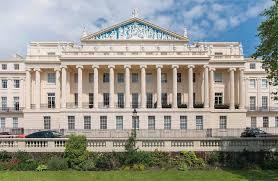
John Nash, James Thomson St. Maryelbone, 1826. Cumberland Terrace. Londra
In Gran Bretagna il Classicismo si impose e gli stili precedenti ma in continuità visto che sin dai tempi dell'architetto Inigo Jones (1573-1652) si era sviluppata in quel Paese un'ininterrotta tradizione classica, in cui erano evidenti soprattutto gli influssi del Cinquecento italiano, in particolare di Andrea Palladio e di Vincenzo Scamozzi.Nel corso del Settecento, poi, lo stile palladiano di lord Burlington aveva reppresentato un deciso contraltare alle forme barocche, rococò, anticipando quello che verrà definito l'Adam Style da Robert Adam (1728-1792), architetto che seppe fondere elementi palladiani e rinascimentali in edifici per i quali curava anche i singoli aspetti dell'arredo interno, la sua opera presenta una rara omogeneità e completezza. Le ville di campagna e i complessi residenziali realizzati da Robert Adam, sono caraterizzati non solo per la ricerca di un'armonia complessiva, ma anche per il senso di comodità e di intimità, oltre che di sobria eleganza, che connota gli interni, ornati spesso i bianchi stucchi del raffinato disegno. La solennità dell'ambiente convive con la leggerezza crommatica, come nel salone d'ingresso di Syon House (dal 1761), nei pressi di Londra, la partizione lineare delle pareti contrasta con lo schema geometrico del pavimento a marmi bianchi e neri. -Così John Nash (1752-1835) realizzò a Londra tra il 1812 e il 1827, nell'ambito di un ampio rinnovamnto urbanistico, il grandioso corso di Regent Street, su cui si affacciano edifici monumentali di impronta scenografica, provvisti di prospetti pieni di colonne e di statue, quasi per rinnovare i fasti della Roma imperiale.John Soane (1753-1837), capace di progettare edifici ancora memori del Barocco, altri ispirati a un razionalismo che si direbbe derivato da Boullée e Ledoux (dell'Old Colonial Office, del 1818-1823), come la casa londinese dell'artista, dove oggi è allestito Soane's Museum, frutto della più stravagante combinazione di elementi.
Il Neoclassicismo in Germania
In Germania, dove già nel 1789 Karl Gotthard Lnghans (1732-1808) si era ispirato all'Acropoli per la berlinese Porte di Brandeburgo, l'architettura conobbe una declinazione classicista grazie soprattutto a Karl Friedrich von Schinkel (1781-1841), e a Leo von Klnze (1784-1844), che con i suoi edifici di composta monumentelità e le grandiose piazze diede a Monaco quel carattere che ancora oggi la distingue.
Il Neoclassicismo negli Stati Uniti

William Thornton, Benjamin Latrobe, Charles Bulfinch, Campidoglio. 1792-1827. Washinghton
Thoomas Jefferson (1743-1826), era stato il principale redattore della Dichiarazione d'indipendenza del 1776 e sarà poi eletto presidente degli Stati Uniti per due successivi mandati (1801-1809). Fu lui, cultore di architettura che realizzò la propria residenza di Monticello (presso Charlottesville) in stile neoclassico (1771, poi ristruturata nel 1793-1809) e che prese a modello per il Campidoglio di Richmond (1785-1796) la Maison Carrée di Nimes. A partire dal 1817, progettò l'Università della Virginia. Nel fondo spicca la biblioteca modellata sul Pantheon, mentre ai lati si allineano cinque padiglioni per parte, collegati dda porticati e caratterizzati ognuno da una particolare tipologia architettonica in modo che gli studenti possono accostarsi ai diversi stili. La prima stazione ferroviaria di Lowell, nel Massachusetts, del 1835, aveva un esempio la forma di un tempio greco e l'unico binario esistente passava sotto il colonnato.
Il Neoclassicismo in Francia

Alexandre-Pierre Vignon, Chiesa della Madeleine, 1807-1842
Il Classicismo si impone in Francia soprattutto durante l'Età napoleonica. Punto di riferimento privilegiato divenne l'arcitettura dell'età imperiale romana, dalla quale venne ripreso, per esempio, il modello dell'arco di trionfo. Per celebrare Napoleone nel 1806 Jean François Chalgrin (1739-1811) diede inizio a Parigi all'Arco di Trionfo, completato solo molo più tardi, nel 1837, a causa delle contestazioni cui venne sottoposto il progetto e della caduta dell'Imperatore. Gli architetti preferiti da Napoleone erano però Charles Percier (1764-1838) a Pierre-François-Léonard Fontaine (1762-1853), che erano stati allievi di Boullée e che ebbero il compito di ristrutturare Parigi dal punto di vista urbanistico e architettonico. Rue de Rivoli e la zona attorno a Place Vendome, la costruzione nel 1806-1810 dell'Arc du Carrousel su iimitazione di quello di Settimo Severo nel Foro romano, l'arredamento di parecchi palazzi e castelli. Al e il 1827) e exandre-Pierre Vignon (1762-1846) comimciò a trasformare completamente la Chiesa della Madeleine, che era stata iniziata nel 1764, in un Tempio della Gloria dedicato alla Grande Armée: appoggiata su un alto basamento e circondata tutt'attorno da grandi colonne corinzie, poi restituita dal culto cattolico con la Restaurazione e infine completata solo nel 1842. La chiesa di Sainte Geneviève, dedicata a Santa Genoveffa, che Luigi XV aveva voluto in voto dopo la guarigione di una grave malattia. L'archtetto Jacques-Germain Soufflot (1713-1780) si era ispirato al PAntheon di Roma e Panthéon venne chiamato durante la Rivoluzione l'edificio, destinato a opsitare le tombe dei grandi di Francia.
Il Neoclassicismo di Giacomo Quarenghi e Carlo Rossi
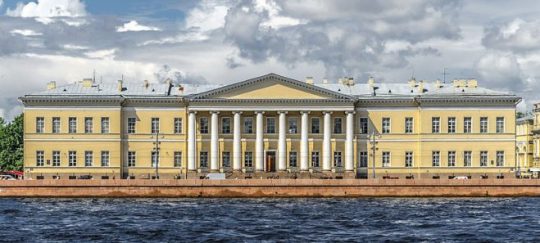
Giacomo Quarenghi, Palazzo dell'Accademia delle Scienze, 1783-1787. San Pietroburgo
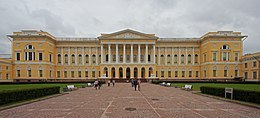
Carlo Rossi. Palazzo Mikhailovskj. 1819-1825. Facciata sulla Piazza delle Arti
In Russia il Neoclassicismo si espresse soprattutto attraverso il bergamasco Giacomo Quarenghi (1744-1817). Quando arrivò in Russia nel 1780, su invito della zarina Caterina II, aveva ale spalle una serie di viaggi in Francia e in Gran Bretagna. Continuò a lavorare, Paolo I e Alessandro I, contribuendo in maniera determinante a creare il volto di San Pietroburgo secondo una prevalente impostazione neoclassica. Per la città, la capitale della Russia, Quarenghi progettò svariati edifici, dal Teatro dell'Ermitage (1783-1787), che riprende lo schema compositivo del teatro anntico e del Teatro Olimpico del Palladio, all'Accademia delle Scienze (1783-1787), alla Banca di Credito (1783-1790), alla Borsa (1784-1801). In tutte queste opere si avverte un senso di equilibrio e di elegante proporzione, attraverso la personale rielaborazione dei modelli palladiani. San Pietroburgo dal napoletano Carlo Rossi (1775-1849), che ralizzò nella città sulla Neva interi quartieri tra il 1819 e il 1827) e la Piazza d'Inverno (1819-1827)
#madamevrath storia arte cultura neoclassicismo imperonapoleonico NapoleonBonaparte#francia Germania StatiUniti GranBretagna ottocento architettura scultura
2 notes
·
View notes
Photo


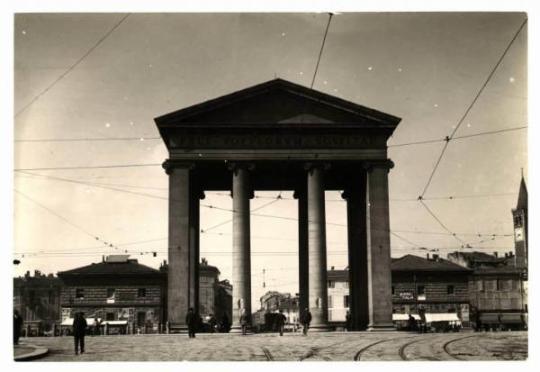
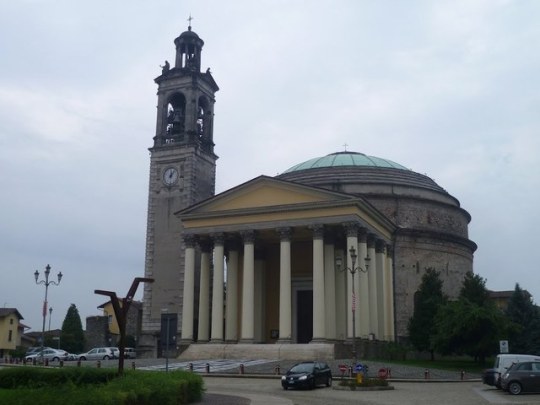

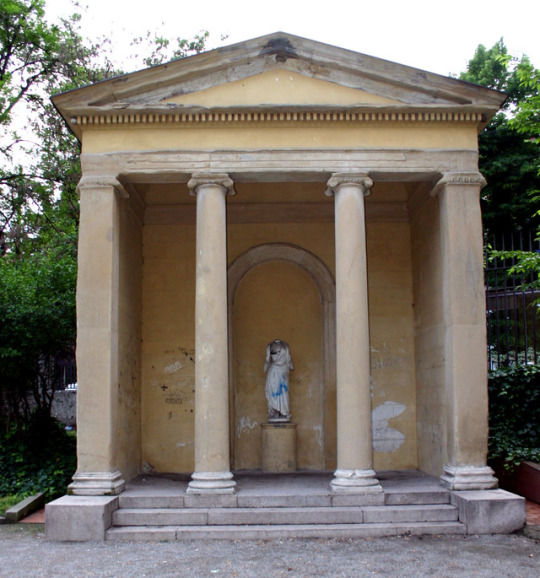
By Jean Marie Carey
Architect Luigi Cagnola died 14 August 1833 in Como. Born in Milan in 1762, Cagnola was a prodigy who attended Collegio Pio Clementino in Rome as a teenager and earned a law degree from the University of Padua by the time he was 20 years old. Cagnola had a particular interest in the restoration of historic buildings, carefully conforming his repairs to the style of the original architecture.
Milan’s first Arco della Pace (1806) near Porta Orientale was temporary, erected by Cagnola to celebrate the marriage of the Viceroy Eugène de Beauharnais to Amalia of Bavaria. It was so admired that it was rebuilt in marble on the Strada del Sempione in 1807. Several of Cagnola’s most successful works were produced in the last 20 years of his life, including the Campanile at Urgnano and his own villa at Inverigo, near Como.
Reference: Gianni Mezzanotte. “Cagnola, Luigi.” Grove Art Online. Oxford Art Online. Oxford University Press. <http://www.oxfordartonline.com/subscriber/article/grove/art/T012996>.
Arco della Pace, Milan, 1807. Photo from Wikimedia Commons.
Sant'Ambrogio Basilica, Milan. Originating in the15th century, the basilica was restored in 1812 by Cagnola. Photo from Wikimedia Commons.
Porta Ticinese, Milan, dating from the 12th Century; restored by Cagnola c. 1810. Photo from Lombardia Cultural Heritage Foundation.
Neoclassical temple at Giardini della Guastalla, Milan. Photo from Wikimedia Commons.
Benedetto Cacciatori, Monument to Luigi Cagnola, Palace of Brera, Milan. Photo from Wikimedia Commons.
Campanile at Urgnano, c. 1825. Photo from Wikimedia Commons.
Further Reading: Michela Rossi, Sylvie Duvernoy, and Giampiero Mele. Milano. Maths in the City: A Mathematical Tour of Milanese Architecture. Rimini: Maggioli, 2012.
Jack Basehart and Ralph Toledano. Italian Splendor: Castles, Palaces, and Villas. New York: Rizzoli, 1990 (Reissued 2015).
43 notes
·
View notes
Text
20 Ingenious Ways You Can Do With Raphael Paintings | Raphael Paintings
ROME — The once-in-a-lifetime affectation took three years to appear together. Organizers abiding for the accurate carrying of Raphael masterpieces loaned from London, Washington, Florence, Madrid. The allowance bill was $4.4 billion.
Renoir – raphael paintings | raphael paintings
One 1510 painting, “Alba Madonna,” had belonged over the centuries to Spanish nobility, the emperor of Russia, and American broker Andrew Mellon, who acquired it in a abstruse Soviet art sell-off.
At last, it was aback in Italy for the aboriginal time aback the 17th century.
Hertfordshire Genealogy: Postcards – Aritsts – raphael paintings | raphael paintings
Just in time for the pandemic.
The affectation appearance the 500th ceremony of Raphael’s afterlife coincided with Italy’s coronavirus lockdown and was apoplectic in aboriginal March afterwards all of four days.
Staircase Group | Encyclopedia of Greater Philadelphia – raphael paintings | raphael paintings
“It was as if the works were in a coffer vault,” said Marzia Faietta, one of the collection’s two curators.
Even as Italy now moves to reopen its acclaimed cultural sites, including the Raphael exhibit, the abiding restrictions of the communicable accept badly afflicted how broadly they can be seen.
Raphael | Italian painter and architect | Britannica | raphael paintings
There has conceivably never been a better, or harder, time to acquaintance Italy’s adorableness and treasure.
Monuments such as the Colosseum crave temperature checks and advance bound admission quotas. Wonders like the Sistine Chapel acquiesce dinner-party-sized gatherings but not the accepted arena-sized crowds. And exhibits advised as all-embracing contest – like the one adherent to Raphael – accept had to calibration cut aback their circadian capacity, to almost one-third of what was initially imagined, to attach to amusing break rules.
Raphael | Biography, Artworks, & Facts | Britannica – raphael paintings | raphael paintings
Italy affairs to lift its centralized biking restrictions and accessible its borders to European tourists on Wednesday.
20 Ingenious Ways You Can Do With Raphael Paintings | Raphael Paintings – raphael paintings
| Welcome for you to my website, in this particular moment I am going to demonstrate concerning keyword. And from now on, this can be a very first graphic:
Carbonne. L’église Saint-Laurent | raphael paintings
How about picture above? can be in which remarkable???. if you believe therefore, I’l t provide you with several image yet again beneath:
So, if you would like acquire all of these magnificent pics about (20 Ingenious Ways You Can Do With Raphael Paintings | Raphael Paintings), press save icon to save the pictures for your pc. These are all set for down load, if you’d prefer and wish to take it, just click save badge on the post, and it’ll be directly saved to your notebook computer.} As a final point in order to gain unique and the recent image related to (20 Ingenious Ways You Can Do With Raphael Paintings | Raphael Paintings), please follow us on google plus or bookmark the site, we attempt our best to provide regular up-date with all new and fresh pics. Hope you enjoy keeping right here. For some updates and recent information about (20 Ingenious Ways You Can Do With Raphael Paintings | Raphael Paintings) pics, please kindly follow us on tweets, path, Instagram and google plus, or you mark this page on bookmark section, We try to present you up-date periodically with fresh and new photos, love your browsing, and find the perfect for you.
Thanks for visiting our website, articleabove (20 Ingenious Ways You Can Do With Raphael Paintings | Raphael Paintings) published . Nowadays we’re pleased to announce we have discovered an awfullyinteresting topicto be discussed, that is (20 Ingenious Ways You Can Do With Raphael Paintings | Raphael Paintings) Many people attempting to find info about(20 Ingenious Ways You Can Do With Raphael Paintings | Raphael Paintings) and certainly one of these is you, is not it?
RAPHAEL – Paintings by Raffaello Sanzio in the .. | raphael paintings
Raphael Paintings Reproductions 1 – raphael paintings | raphael paintings
Raphael | Italian painter and architect | Britannica | raphael paintings
14 of the Most Famous Paintings and Artworks by Raphael .. | raphael paintings
_ RAFFAELLO, SPOSALIZIO DELLA VERGINE _ – raphael paintings | raphael paintings
30 Interesting And Fascinating Facts About Raphael – Tons .. | raphael paintings
Raphael | Watercolor Journal – raphael paintings | raphael paintings
The Aldobrandini Madonna Or The Garvagh Madonna Painting .. | raphael paintings
Facts About Raphael the Artist: One of the Great High .. | raphael paintings
The Virgin Of The Rose Painting by Raphael – raphael paintings | raphael paintings
RAPHAEL: Hailed as the greatest painter of the Renaissance .. | raphael paintings
Flight Of The Mud Geese – raphael paintings | raphael paintings
Raphael Paintings Reproductions 1 – raphael paintings | raphael paintings
Mariano Rossi (1731 – 1807) – la civiltà romana e l’eroica virtù dell’onore (1775-1779) – Volta del Salone d’ingresso – Galleria Borghese Roma – raphael paintings | raphael paintings
from Wallpaper Painting https://www.bleumultimedia.com/20-ingenious-ways-you-can-do-with-raphael-paintings-raphael-paintings/
0 notes
Photo

Juno, Mariano Rossi, 1731–1807, Smithsonian: Cooper Hewitt, Smithsonian Design Museum
Medium: Brush and brown wash, pen and ink, graphite on paper.
http://collection.cooperhewitt.org/view/objects/asitem/id/68302
2 notes
·
View notes
Text
Baby Robins and Tiny Ladybugs
read it on the AO3 at https://ift.tt/35tKzaB
by Sparkle9510
Marinette may no longer have to face expulsion, but that doesn't stop Lila from spreading lies to try to turn the class against her. With only a handful of people still by her side, she does her best to debunk each and every lie to prevent the rest of the class from falling too deep. It wasn't too hard since some of her lies were easily proven to be false.
But then Lila claims to be @BelleOfGotham, the talented social media star and close friends of the Waynes, especially the ice prince, Damian Wayne. The one no one knows the identity of. That is, no one but Marinette.
After all, why wouldn't she? She's the real person behind @BelleOfGotham!
Words: 1807, Chapters: 1/?, Language: English
Fandoms: Miraculous Ladybug, Batman - All Media Types
Rating: Teen And Up Audiences
Warnings: No Archive Warnings Apply
Characters: Marinette Dupain-Cheng | Ladybug, Damian Wayne, Adrien Agreste | Chat Noir, Lila Rossi, Alya Césaire, Nino Lahiffe, Bruce Wayne, Jason Todd, Dick Grayson, Tim Drake, Gabriel Agreste | Papillon | Hawk Moth, Nathalie Sancoeur
Relationships: Marinette Dupain-Cheng | Ladybug/Damian Wayne
Additional Tags: Lila Rossi's Lies Are Exposed, Protective Adrien Agreste | Chat Noir, Protective Nino Lahiffe, Chloé Bourgeois Redemption, at first i was thinking of salt, but nahhh the class will regain their braincells eventually, one by one though, Marinette Dupain-Cheng | Ladybug & Lê Chiến Kim & Nino Lahiffe Friendship, Badass Marinette Dupain-Cheng | Ladybug, no beta we die like like akumas
read it on the AO3 at https://ift.tt/35tKzaB
0 notes
Photo
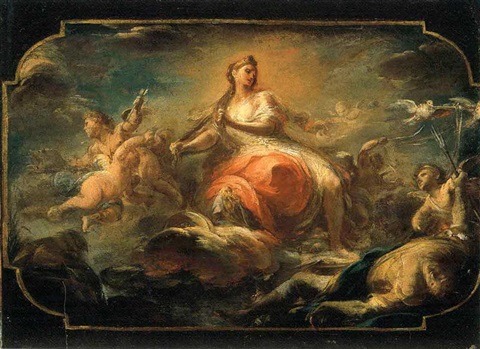
Mariano Rossi (1731–1807)
Venus et Adonis
6 notes
·
View notes
Text





from https://ift.tt/2fzNu8Y https://ift.tt/2Qr7WO0
peashooter85: Silver mounted sabre crafted by Anton Rossi,...
Silver mounted sabre crafted by Anton Rossi, Vienna, 1807.
from The Museum of Applied Arts, Budapest
0 notes
Photo
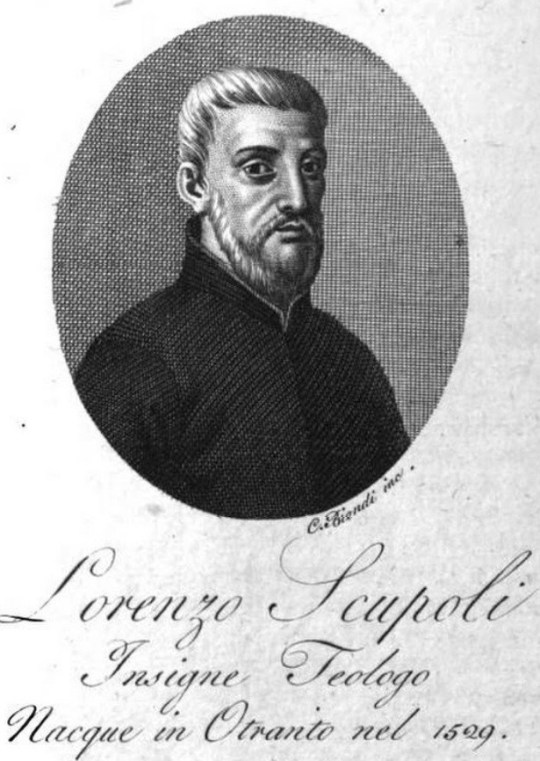
Nuovo post su http://www.fondazioneterradotranto.it/2018/11/01/lorenzo-scupoli-1530-1610-di-otranto-e-il-suo-best-seller-senza-tempo/
Lorenzo Scupoli (1530-1610) di Otranto e il suo best seller senza tempo
di Armando Polito
Strano mondo il nostro, che si è inventato il disco d’oro per i cantanti che vendono 25.000 copie, di platino per chi ne vende 50.000 e di diamante per chi raggiunge le 500.000. Come se non bastasse il disco, d’oro c’è pure il pallone e, per chiudere adeguatamente, pure la pensione che in moltissimi casi è il riconoscimento di un impegno politico diretto (a rappresentare il più delle volte interessi personali o di consorteria) o indiretto, cioè legato a funzioni o cariche rivestite su designazione politica. Nessun libro, nemmeno di cartone, invece, per i letterati che abbiano venduto un certo numero di copie, anche se il successo di vendita, come succede pure con i prodotti alimentari o con quelli igienici, non è necessariamente prova di qualità. A dire il vero esiste il Libro d’oro della nobiltà italiana, sul quale, per non perdere tempo, evito di fare riflessioni più o menp in linea con quelle già fatte per le pensioni d’oro.
Ad ogni modo, se esistesse un libro d’oro come lo intendo io, da tale onorificenza non andrebbe escluso Lorenzo Scupoli, degno di fare compagnia agli autori classici che, anche per le stampe e le ristampe, possono essere considerati senza tempo.
Il libro d’oro in questione sarebbe il suo Il combattimento spirituale, opera di edificazione in cui addita gli strumenti per raggiungere la perfezione interiore. Pensando ai nostri tempi così proni all’immagine e alle apparenze c’è da chiedersi quale successo ancor più grande avrebbe riscosso quest’opera se k’autore vi avesse inserito qualche suggerimento per apparire più belli esteriormente …
E, a proposito d’immagine, ecco le poche testimonianze iconografiche che son riuscito a trovare del nostro.
La più datata è una tavola presente in un’edizione de Il combattimento spirituale uscita per i tipi della Stamperia Reale a Parigi nel 1660 con dedica a papa Alessandro VII, al secolo Fabio Chigi, già vescovo di Nardò. Prima della tavola presento il frontespizio.
Nel dettaglio in basso a sinistra l nomi del disegnatore e dell’incisore:
N. Loyre delin(eavit) Aig(idius) Rousselet sculp(sit) [N. Loyre disegnò, Egidio Rousselet incise]
Il Rousselet era nato a Parigi nel 1614 e vi morì nel 1686. Non è dato sapere a quali fonti il disegnatore si ispirò per il dettaglio del volto del nostro che di seguito riproduco ingrandito.
SI direbbe che ad esso si rifacciano i successivi ritratti.1
Il primo è a corredo della biografia dello Scupoli a firma di di Domenico De Angelis nel suo Le vite de’ letterati salentini, Raillard, Napoli, 1713, v. II, pp. 7-18.
Laurentio Scupulo Hydruntino Congr(egationis) ge(neralis) Cleric(o) Regular(i)/Dominicus de Angelis D(ONO) d(EDIT) d(edicavit) [A Lorenzo Scupoli chierico regolare della Congregazione generale Domenico De Angelisin dono diede (e) dedicò]
Il secondo è a corredo di Certamen spirituale (traduzione in latino de Il combattimento spirituale), Rieger, Augusta, 1781
Vera Effigies Venerabilis P(atris) Laurentii Scupuli/Hydruntini Clerici Regularis, qui obiit Neapoli/A(nn)o MDCX [Vera immagine del venerabile padre Lorenzo Scupoli chierico regolare di Otranto, che morì a Napoli nell’anno 1610]
Nel margine inferiore a sinistra Gottfrid Eichler delineavit (disegnò Goffredo Eichler)
e a destra Tobias Lobeck sculp(sit) [Tobia Lobeck incise]
La famiglia Eichler, tedesca, annoverò parecchie generazioni di pittori. Quello della tavola dovrebbe essere Matteo Goffredo (1748-1809 in Pietro Zane, Enciclopedia mertodica critico-ragionata delle belle arti, parte I, v, VIII, Tipografia ducale, Parma, 1821). Nella citata enciclopedia (parte I, v. XII, Tipografia ducale, Parma, 1822) Tobia Lobeck è riportato come attivo nel 1744.
Il terzo è a corredo della biografia del nostro a firma di A. Mazzarella da Cerreto in Biografia degli uomini illustri del regno di Napoli, Gervasi, tomo V, Napoli, 1818.
Non mi rimane a questo punto, a dimostrazione dell’assunto iniziale, che riportare le varie edizioni distinte per secolo, comprese le numerose traduzioni (evidenziate con sottolineatura) in latino(, francese, spagnolo, portoghese, tedesco, inglese e lituano, che attestano lo spessore internazionale dell’opera.
XVI
Gioliti, Venezia, 1589, 1591 e 1593
Ventura, Bergamo, 1593
n., Venezia, 1594
Zanni, Cremona, 1594
Faccioptto, Roma, 1594
Srmantelli, Firenze, 1596
Brea, Messina,1598
Sermartelli, Firenze, 1598
Muzio, Roma, 1598
Gioliti, Venezia, 1599
Bordone-Locarno, Milano, 1599
XVII
Sermartelli, Firenze, 1600
Belpiero, Cremona, 1603
Longo, Napoli, 1605
Giunti e Ciotti, Venezia, 1609
Stamperia reale, Parigi, 1609 e 1660
Lefuel, Parigi, 1610 (Le combat spirituel)
Gargano-Nucci, Napoli, 1610
Orlandi & Decio Cirillo, Palermo, 1615
Cochi, Bologna, 1607e 1615
Ciotti, Venezia, 1617
Belleri, Douai, 1625 (Pugna spiritualis, Tractatus vere’ aureus: de perfectione vitae christianae, traduzione in latino di Lorich Josocus). Questa traduzione in latino fu ristampata da Martin a Parigi nel 1662.
Combi, Venezia, 1634
Tesor del Monte, Colonia, 1642
De Rossi, Verona, 1652
Costantini, Venezia-Perugia, 1656-1657
Mascardi, Roma, 1657
Le Petit.Parigi, 1657 (Le combat spirituel, traduzione in francese)
Guillaume de Luyne, Parigi, 1658 (Le combat spirituel, traduzione in francese)
Marcher, Parigi, 1658 (dedicato ad Alessandro VII) traduzione in francese di Olimpo Masotti seguita, pagina per pagina, dal testo quello originale in italiano)
Stamperia reale, Parigi, 1660
Martin, Parigi, 1662 (Pugna spiritualis. Tractatus vere aureus de perfectione, vitae Christianae, traduzione in latino di Lorich Jodocus. Questa traduzione in latino era stata già stampata da Belleri a Douai nel 1625.
Stamperia reale, Parigi 1663
Strauber, Vagnon, 1663 e 1667 (Certamen spirituale, traduzione in latino di Carlo Antonio Meazza)
Pezzana, Venezia, 1664
Ignatio de’ Lazari, Roma, 1664-1665
Pezzana, Venezia, 1671
Miloco, Venezia, 1675
Bertier, Parigi, 1676 (Le combat spirituel, traduzopne in francese)
Costa, Lisbona, , 1677 (Combat spiritual, traduzione in spagnolo di Camillo Sanseverino)
Carteron, Lione, 1680, 1681 e 1688 (Le combat spirituel. traduzione in francesae si Olimpo Masotti)
Curti, Venezia, 1681
Tizzoni, Roma, 1682
Vannacci, Roma, 1684-1685
Carteron, Lione, , 1689 (Le combat spirituel, traduzione in francese di Olimpio Masotti)
Longhi, Bologna, 1694
Noethen, Comia, 1692 (Certamen spirituale, traduzione in latino di Cralo Antonio Meazza)
Pezzana, Venezia, 1695
Villette, Parigi, 1696 (Le combat spirituel, traduzione in francese di Alexis Du Buc)
Besson, Lione, 1696 (Le combat spirituel, traduzione in francese di J. Brignon)
Uannacci,Roma, 1698
Osmont, Parigi, 1698 (Le combat spirituel, traduzione in francese di Alexis du Buc)
XVIII
De Rossi, Roma, 1700
Rossetti, Parma, 1701
Louisa, Venezia, 1703
Pezzana, Venezia, 1703 e 1718
Noethen, Colonia, 1707 (Certamen spirituale, traduzione d Carlo Antonio Meazza)i
Marelli, Milano, 1710
Sibert, Lione, 1711 (Le combat spirituel, traduzione in francese di di Alexis du Buc)
Eredi Perri, 1713, Roma
Louisa, Ceneda, 1713
Pezzana, Venezia, 1714 e 1722
Schilgen, Vienna, 1722 (Combate espiritual, traduzione in spagnolo di Damian Gonzalez del Cueto)
Comino, Padova, 1724
Salvioni, Roma, 1725
Pezzana, Venezia, 1728
Pezzana, Venezia, 1735
Zempel, Roma, 1736
Comino, Padova, 1737
Pisarri, Bologna, 1739
Salvioni, Roma, 1740
Pezzana, Venezia, 1741
Eredi del Ferri, Roma,1742
Accademia reale, Lisbona (Combate espiritual. traduzione in portoghese di Thomas Begueman)
Remondini, Bassano, 1745, 1746, 1751 , 1763 e 1770
Tevernini, Venezia, 1747 e 1756
Pezzana, Venezia, 1748
Marelli, Milano, 1749
Comino, Padova, 1724
Borsi, Parma, 1756
Ponzone,Torino, 1757
Pezzana, Venezia, 1741 e 1761
Roselli, Napoli, 1759
Occhi, Venezia, 1748 e 1761
Ricca, Torino, 1765
Cstellano-Manfredi, Napoli, 1765
De Trattner, Vienna, 1765 (Le combat spirituel, traduzione in francese diJean Brignon)
Barbiellini, Roma, 1769
Remondini, Venezia, 1770
Pezzana, Venezia, 1773, 1775 e 1776
Brocas, Parigi, 1774 (Le combat spirituel, traduzione in francese di Jean Brignon)
G. Le Mercier, Parigi, 1775 (Le combat spirituel, traduzione di Jean Brignon)
Floteront, Nizza, 1776
Peyrasso e Scotto, Pinerolo, 1779
Rieger, Augusta, 1781 (Certamen spirituale, traduzione in latino)
Davico, Torino, 1785
Gatti, Venezia, 1789
Irlandelli, Venezia, 1795
XIX
Haydock, Manchester, 1801 (The spiritual combat, traduzione in inglese)
Pezzana, Venezia, 1807
Rusand, Lione, 1808 (Le combat spirituel, traduzione in francese di J. Brignon)
Destefanis, Milano, 1814
Molinari, Venezia, 1816
Eymery, Parigi, 1818 (Le combat spirituel, traduzione in francese di J. Brignon
Pickering & C., Dublino, 1818 (The combact spiritual, traduzione in inglese)
Boget, Lione, 1820 (Le combat spirituel, traduzione in francese di J. Brignon)
n., Parigi, 1820 (Le combat spirituel, traduzione in francese di J. Brignon)
Petit, Besançon, 1820 (Le combat spirituel, traduzione in francese di J. Brignon)
Molinari, Venezia, 1824
Giordano, Napoli, 1825
Montarsolo, Besançon, 1829 (Le combat spirituel, traduzione in francese di di Jean. Brignon
Molinari, Venezia, 1830
Pogliani, Milano, 1830
Dozio, Milano, 1830-1831
Marietti, Milano, 1832
Marietti, Torino, 1833, 1868, 1870, 1880, 1884 e 1890
Fratelli Perisse Parigi, 1835 e 1868 (Le combat spirituel, traduzione in francese di Jean Brignon)
Marietti, Trento, 1835 e 1836
Rousseau, Gand, 1836 (Le combat spirituel, traduzione in francese)
Borel e Bompard, Napoli, 1837
Salviucci, Roma, 1837
n., Napoli, 1837
Stamperia fiiantropica, Napoli, 1837 e 1844
Grazzini, Firenze, 1840
Pirotta, Milano, 1840
Pélagaud e Lesne, Lione. 1840 (Le combat spirituel, traduzione in francese di Jean Brignon)
Marietti, Torino, 1843, 1868, 1870 e 1890
Richardson and son, Derby, 1843 (The spiritual combat, traduzione in inglese)
Gilberti, Brescia, 1844
Burns, Lonfra, 1846 (The spiritual combat, traduzione in inglese)
Eredi Botta, Torino, 1851
Gilberti, Brescia, 1851
Festa, Napoli, 1852
Argenio, Napoli, 1853
Oliva, Milano, 1857
Battezzati-Frisiani, Milano, 1857
Frizierio, Verona, 1859
Lyon ; Paris : Perisse freres, 1856 e Mame, Tours, 1857 (Le combat spirituel, traduzione in ftsncese di Jean Brignon)
Le Clere, Parigi, 1860 (Le combat spirituel, traduzione in francese)
Dessain, Mechliniae, 1862 (Pugna spiritualis, traduzione in latino di Olimpio Masotti)
Rossi-Romano, Torino, 1865
Cramoisy, Parigi, 1666 (Combate espirituale, traduzione in spagnolo di Camillo Sanseberino)
Bertola, Piacenza, 1875
Rivingtons, Londra, 1876 (The spiritual combat, traduzione in inglese)
Mame e figli, Tours, 1880 (Le combat spirituel, traduzione in francese di Jean Brignon)
Roma, S.C. di Prop. Fide, 1881
Guigoni, Milano, 1886
Calleja, Madrid, 1899 (Combate espiritual, traduzione in spagnolo di Damian Gonzalez Cueto9
XX
Marietti, Torino, 1900
Marietti, Torino, 1904
Ghirlanda, Milano, 1906
Kavas, 1908 (Dvasiškoji kova, traduzione in lituano di Antanas Šmulkštys)
Madella, Sesto S. Giovanni, 1912
Marietti. Roma-Torino, 1909, 1916, 1920, 1926 e 1932
Pia società San Paolo,Alba, 1927 e 1930
Pia società San Paolo, Messina, 1935
Roma, Pia Società San Paolo, 1939
S.E.I., Torino, 1941
Marietti, Torino, 1944 e 1948
S.A.S., s. l., 1943
The Newman Press, Usa, 1950 (The spiritual combat, traduzione in inglese)
Edizioni Paoline, Pescara, 1960
Bertoncello, Cittadella, 1974
Mowbrays, Londra-Oxford, 1978 (The spiritual combat, traduzione in inglese di E. Kadloubovsky e G. E. H. Palmer )
Rusconi, Milano, 1985
Edizioni Paoline, Torino, 1992
San Pablo, Madris, 1996 (Combate espiritual, traduzione in spagnolo di Jpsé A.Pérez Sanchez)
Banca Antoniana popolare veneta, Padova, 1997
XXI
San Paolo, Cinisello Balsamo, 1994, 2000 e 2005
Ignatius Press, Spiritual combat revisited, San Francisco, 2003
Amicizia cristiana, Chieti, 2007
San Paolo, Cinisello Balsamo, 2013 e 2015
Scriptoria Books, s. l., 2014 (The spiritual combat, traduzione in inglese)
Le vie della cristianità, EPUB, 2016
_______
1 In rete ne sono sono reperibili numerosi, purtroppo senza indicazione della fonte. Il più curioso, comunque, rimane quello utiilizzato per la celebrazione del quarto centenario della morte (di seguito lo riproduco da http://www.musicaimmagine.it/lorenzo_scupoli_interna.php?id=1), chiaramente derivato dalla tavola dell’edizione parigina del 1660, con aggiunta della berretta.
#Armando Polito#Domenico De Angelis#Goffredo Eichler#Lorenzo Scupoli#Tobia Lobeck#Libri Di Puglia#Pagine della nostra Storia#Spigolature Salentine
0 notes
Photo

Senza titolo #1807 di kirsten-weigh contenente Lipstick Queen
Cropped turtleneck, €2,23 / Carven short wrap skirt, €220 / Gianvito Rossi beige suede boots, €525 / Louis Vuitton leather crossbody handbag, €1.340 / Alexander wang earrings, €185 / Michael Kors slim wrist watch, €160 / Lipstick Queen lip makeup, €25
#polyvore#moda#style#Carven#Gianvito Rossi#Louis Vuitton#Alexander Wang#Michael Kors#Lipstick Queen#fashion#clothing
0 notes